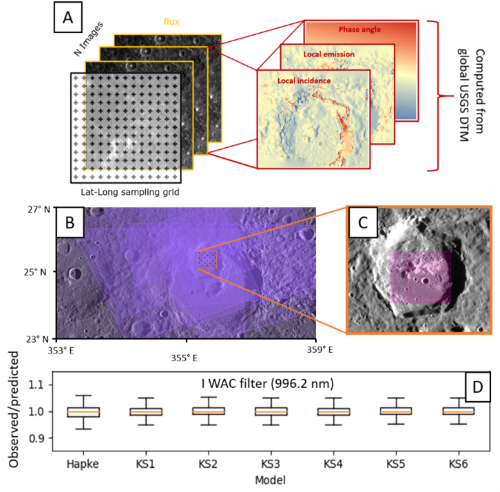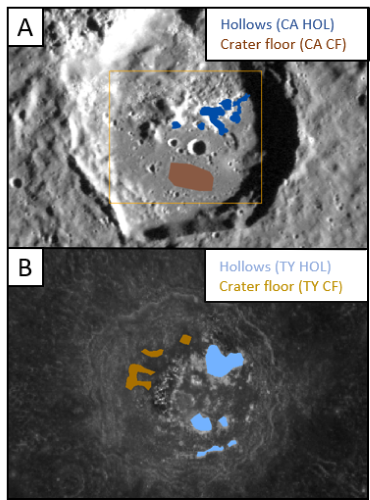Exploring the spectrophotometric properties of hollows from MESSENGER MIDS/WAC multiangular observations
- 1INAF, Osservatorio Astronomico di Padova, Padova, Italy(giovanni.munaretto.1@phd.unipd.it)
- 2Department of Physics and Astronomy “G. Galilei”, University of Padova, Padova, Italy
- 3Department of Geological Sciences, University of Padova, Padova, Italy
Introduction: The origin and formation of Hollows, puzzling surface features identified on MESSENGER (MErcury Surface, Space ENvironment, GEochemistry, and Ranging, [1]) images [2], represent one of the major open science questions about Mercury surface processes and landforms. Hollows are 10 m to several km-sized shallow, irregular, flat‐floored depressions characterized by bright interiors and haloes and found on crater walls, rims, floors, and central peaks [2,3]. Although a well-established framework explaining their nature and formation is still lacking, current hypotheses envision the release of volatiles from the surface of Mercury [1] through processes like sublimation, desorption, sputtering, micrometeorite impacts and pyroclastic volcanism. In this abstract, we analyze multi-angular Mercury Dual Imaging System (MDIS,[7]) wide angle camera (WAC) color images of hollows-hosting Canova (25.62°N, 3.75°W) and Tyagaraja craters (3.89 °N, 138.9°W), with the aim of investigating the spectrophotometric properties of these features.
Methodology: We collected multiple MDIS/WAC images covering the hollows at Canova and Tjagaraya crater in 8 out of 11 filters ranging from 433 nm to 996 nm. Each image was processed with the ISIS software through the spiceinit and mdiscal and cam2map commands and downsampled to 665 m/px. The phocube task was used to compute the local incidence, emission, phase and solar and spacecraft azimuth. Next, a sampling grid with a scale of 665 m was constructed (Fig. 1A). For all observations in each filter, the flux and the photometric angles are collected at each sampling point (Fig. 1A, 1B). This data was fitted with a basic Hapke model and different version of the Kasalaainen-Shkuratov models (KS1 to KS6 as defined in [8]). The fitted parameters were used to correct each observation to the standard illumination and observation geometry (i.e., incidence=30° and emission=0°) and average all the images in each band to obtain spectra at a higher SNR than those based on a single image of the same resolution.

Figure 1 A) Sketch of the MDIS/WAC Canova dataset. B) WAC G-band image coverage (violet, in transparency. C) Area under investigation (pink square). D) Boxplots of the ratio between the observed and predicted flux for each fitted model.
Results and discussion: The performance of our correction is shown by the box-plots in Fig. 1D. On the y-axis we report the ratio of the observed vs predicted flux for the I (996.2 nm) band. We plot only 1 band for clarity, but the others give similar results. The fitted photometric models allow to reproduce the observed flux values with an error below 10% at 3σ, which is comparable with the radiometric accuracy of the MDIS/WAC datasets.

Figure 2 A) MDIS/NAC global mosaic of Mercury showing Canova crater. The blue and brown areas represent the Canova hollows (CA HOL). And crater floor material (CA CF) ROIs, respectively. B) MDIS/WAC image of Tyagaraja crater. Lightblue and gold areas are the Tyagaraja hollow (TY HOL) and crater floor material (TY CF) ROIs, respectively.
Figure 3 Continuum removed reflectance spectra of Canova and Tyagaraya hollows (CA HOL, TY HOL) and crater floor material (CA CF, TY CF).
Continuum removed reflectance spectra of the hollows and crater floor materials (“CA HOL” and “CA CF” ROIs in Fig. 2A for Canova ,“TY HOL” and TY CF” ROIs in Fig. 2B for Tyagaraja) were extracted from the average of all the corrected images in each band and are shown in Fig. 3. Consistently with the multi-band, MDIS/WAC, clustering-derived spectra from [5], our hollows spectra show an absorption between 600 and 800 nm. From the same ROIs we also extracted the best-fit parameters for all the photometric models. The distribution of the Hapke single-scattering albedo for the hollows and the crater floor material is shown in Fig. 3. In particular, hollows have a higher single-scattering albedo and a more spread distribution than the crater floor material. Interestingly, the hollows distributions are very similar for both craters.
Figure 4 Single scattering albedo (w) parameter for the Canova and Tygaraja Hollows (light-blue and blue histgorams) and crater floor materials (brown and gold histograms) in the MDIS/WAC filters.
Conclusions
We analyzed MDIS-WAC images in 8 out of the 11 WAC filters showing hollows on the floor of Canova and Tyagaraja craters on Mercury. These observations were used to fit several photometric models, allowing to standardize all images and obtain high SNR spectra of hollows and the crater floor material. Consistently with previous works, hollows are characterized by an absorption between 600 and 800 nm. In addition, we are investigating the model parameters for both materials in each band. This preliminary investigation already shows that hollows have a higher and more spread single-scattering albedo distribution than the crater floor material. In addition, the single-scattering albedo distributions of hollows at Canova and Tjagaraya are very similar. This spectrophotometric characterization will be useful to further investigate these features with high-resolution DTMs, color images and spectra from the SIMBIO-SYS [9] instrument onboard BepiColombo. A more in depth spectroscopic and photometric analysis, covering all the Hapke parameters and the considered photometric models will be presented at the conference.
Acknowledgements: This study is supported by the BepiColombo ASI-INAF contract n° 2017-47-H.0.
References: [1] Solomon, S.C., et al., 2007, Space Sci. Rev. Space Sci Rev 131, 3–39, [2] Blewett, D.T. et al, 2011. Science,80; [3] Blewett, D.T. et al., 2013 JGR:Planets,121,9,1798-1813; [4] Vilas, F., et al. 2016, GRL ,43,4, 1450-1456,[5] Lucchetti, A. et al., 2018. JGR:Planets, 123-9,2365-2379, [6] Pajola, M. et al, 2020, PSS, 105136, [7] Hawkins, S.E. et al., 2007. Space Sci Rev 131, 247–338 [9] Domingue, D. et al. 2016, Icarus, 268, 172-203 [9] Cremonese G. et al., 2020. Space Sci Rev 216, 75
How to cite: Munaretto, G., Lucchetti, A., Pajola, M., Cremonese, G., and Massironi, M.: Exploring the spectrophotometric properties of hollows from MESSENGER MIDS/WAC multiangular observations, European Planetary Science Congress 2021, online, 13–24 Sep 2021, EPSC2021-385, https://doi.org/10.5194/epsc2021-385, 2021.

